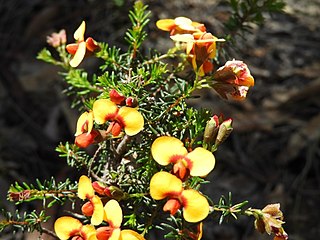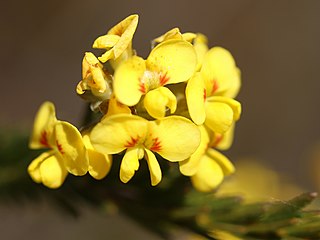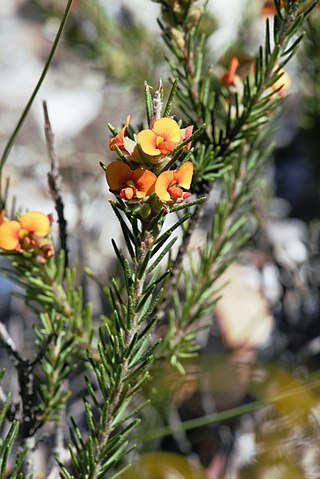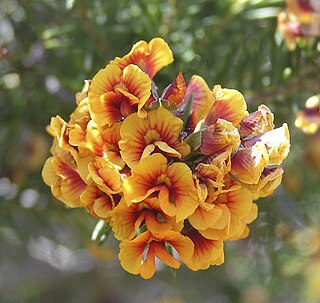
Dillwynia retorta, commonly known as eggs and bacon, is a species of flowering plant shrub in the family Fabaceae and grows in New South Wales and Queensland. It is usually an erect shrub with thin, smooth, crowded leaves and yellow flowers with red markings.

Dillwynia floribunda is a species of flowering plant in the family Fabaceae and is endemic to eastern Australia. It is an erect shrub with hairy stems, crowded, grooved, linear leaves and yellow flowers with red markings.

Dillwynia phylicoides, commonly known as small-leaf parrot-pea, is a species of flowering plant in the family Fabaceae and is endemic to eastern Australia. It is an erect to open shrub with twisted, linear to narrow oblong leaves, and yellow and red flowers.

Bossiaea rupicola is a species of flowering plant in the family Fabaceae and is endemic to eastern Australia. It is an erect shrub or small tree with silky-hairy, narrow egg-shaped to narrow elliptic leaves and red flowers with yellow markings.

Dillwynia elegans is a species of flowering plant in the family Fabaceae and is endemic to eastern New South Wales. It is an erect shrub with more or less cylindrical, grooved leaves and yellow flowers with red markings.

Dillwynia acicularis is a species of flowering plant in the family Fabaceae and is endemic to New South Wales. It is an erect shrub with linear, grooved leaves and yellow flowers with red markings.

Dillwynia brunioides, commonly known as sandstone parrot-pea, is a species of flowering plant in the family Fabaceae and is endemic to New South Wales. It is an erect shrub with silky-hairy stems, linear, grooved leaves and yellow flowers with red markings.

Dillwynia crispii is a species of flowering plant in the family Fabaceae and is endemic to Morton National Park in eastern New South Wales. It is an erect shrub with glabrous, linear leaves and yellow flowers with red markings.
Dillwynia dillwynioides is a species of flowering plant in the family Fabaceae and is endemic to the south-west of Western Australia. It is a low-lying or erect, spindly shrub with cylindrical, grooved leaves and yellow, red or orange flowers with yellow, red or orange markings.

Dillwynia glaucula, commonly known as Michelago parrot-pea, is a species of flowering plant in the family Fabaceae and is endemic to south-eastern New South Wales. It is an erect shrub with lenticels on the stems, linear, grooved leaves and yellow flowers with red markings.
Dillwynia juniperina, commonly known as prickly parrotpea, is a species of flowering plant in the family Fabaceae and is endemic to south-eastern continental Australia. It is an erect, spreading shrub with rigid, linear, sharply-pointed leaves and yellow flowers with red markings.

Dillwynia oreodoxa is a species of flowering plant in the family Fabaceae and is endemic to Victoria, Australia. It is an erect shrub with glabrous foliage, linear leaves and yellow flowers with red markings.
Dillwynia palustris is a species of flowering plant in the family Fabaceae and is endemic to the Snowy Mountains in New South Wales. It is a weakly ascending to low-lying shrub with glabrous stems, linear, spirally twisted leaves and orange or yellow flowers with red markings.

Dillwynia pungens is a species of flowering plant in the family Fabaceae and is endemic to the south coast of Western Australia. It is an erect, spindly shrub with cylindrical leaves and yellow flowers with red or orange markings.

Dillwynia ramosissima, commonly known as bushy parrot-pea, is a species of flowering plant in the family Fabaceae and is endemic to south-eastern continental Australia. It is a low-lying to erect shrub with linear to narrow oblong or spatula-shaped leaves and yellow flowers with red markings.

Dillwynia rudis is a species of flowering plant in the family Fabaceae and is endemic to eastern New South Wales. It is an erect shrub with warty, linear leaves and yellow to orange flowers with red veins.
Dillwynia rupestris is a species of flowering plant in the family Fabaceae and is endemic to the Gibraltar Range National Park in New South Wales. It is an erect, single-stemmed shrub with linear leaves and yellow flowers with red markings.

Dillwynia sieberi, commonly known as Sieber's parrot-pea, is a species of flowering plant in the family Fabaceae and is endemic to eastern Australia. It is an erect shrub with rigid, needle-shaped, sharply-pointed leaves and yellow to yellow-orange flowers with reddish-brown markings.
Dillwynia stipulifera is a species of flowering plant in the family Fabaceae and is endemic to New South Wales. It is an erect to spreading shrub with hairy stems, linear leaves and yellow flowers with red markings.

Pultenaea hispidula, commonly known as rusty bush-pea, is a species of flowering plant in the family Fabaceae and is endemic to south-eastern continental Australia. It is an erect, spreading shrub with many drooping branches, oblong to egg-shaped leaves with the narrower end towards the base, and yellow to pale orange and red flowers.














